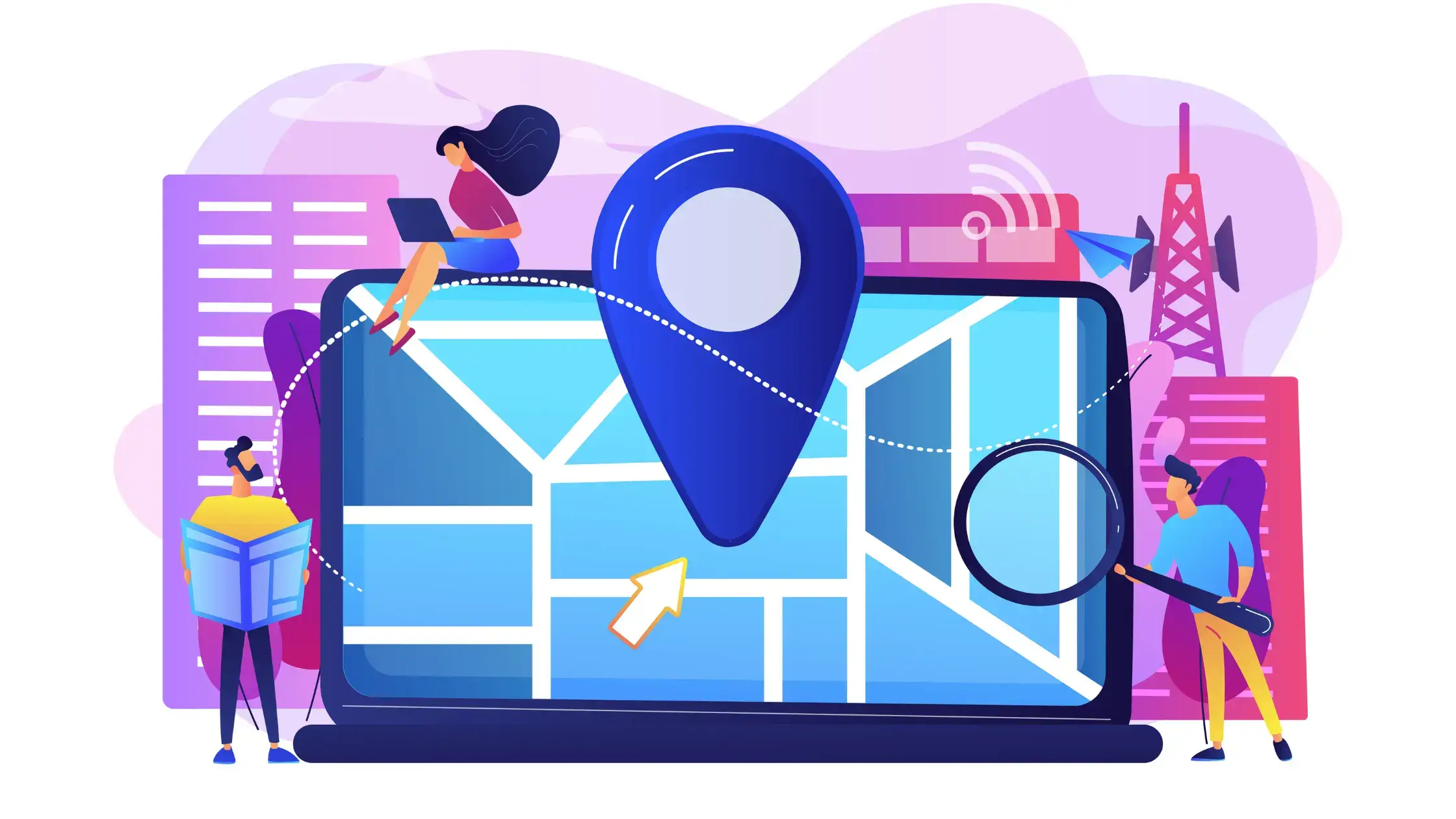In this comprehensive guide to local SEO, we will discuss how to improve your online visibility and attract more customers to your business.
In today's highly competitive digital landscape, a local SEO guide for beginners has emerged as a powerful tool enabling companies to target their local audience effectively.
In this guide, we will navigate the fundamentals of local SEO, exploring its definition, benefits, and techniques that can help you achieve better rankings in local search results.
We will equip you with the knowledge and strategies to analyze your current situation, optimize your Google My Business, build citations on relevant directories, garner customer reviews, and monitor your website's performance.
So, whether you are a local brick-and-mortar store, a service-based business, or an e-commerce venture with a physical presence, this guide will provide the insights and tools necessary to thrive in the local market.

Custom image created in Canva
What is Local SEO?
According to Neil Patel, “SEO is the process of taking steps to help a website or piece of content rank higher on Google.”
"If your content can’t earn a click, it doesn’t matter how high it ranks.” - Shahid Shahmiri
Local SEO (Search Engine Optimization) is a subfield of SEO that focuses on optimizing websites to be found in local search results.
Local SEO increases the visibility of businesses that serve their communities face-to-face.
These may be brick-and-mortar businesses with physical locations, such as grocery stores or dentists' offices, or service-area businesses that operate throughout a certain geographic area, such as an electrician or house cleaning company.
Steps to Develop Local SEO Strategy for Your Small Business
- Analyzing Your Current Situation
- Setting Up a Google My Business Listing
- Building Citations on Relevant Directories
- Unlocking the Power of Customer Reviews and Ratings
- Monitoring Performance Regularly
- Mobile Optimization
- Glossary of Terms
The following are the six steps necessary to develop local SEO for your business and incorporate it into your digital marketing strategy.
By optimizing your website and online presence for local search engine results pages (SERPs), you can establish a strong online presence, outrank your competitors, and connect with potential customers in your area.
1. Analyzing Your Current Situation
-
Researching your business & competitors
If you are starting a company, researching the best cities to start a business can provide access to valuable resources and networks that support growth and help enhance small business communication.
Analyzing your current situation is a crucial step for building a successful business. It guides you toward identifying opportunities, pinpointing weak points, and determining areas that require attention to ensure future growth.
In this context, many plumbing businesses have found success by partnering with a specialized marketing agency for plumbers, which tailors strategies to the unique challenges and opportunities of this industry.
Such agencies understand the specific needs of plumbing businesses and can significantly enhance their online presence and customer engagement.
In this chapter, we will conduct comprehensive research on your business and competitors. You can develop practical approaches by gaining a profound understanding of their strategies.
To begin, immerse yourself in industry trends and market dynamics. Stay up-to-date with the latest developments, emerging technologies, and evolving consumer preferences within your industry.
This knowledge will enable you to identify market gaps and capitalize on new opportunities that align with your business goals.
Next, examine your competitors' websites or services to gain valuable insights. Tools for tracking user activity in web applications like SaaS solutions or on websites can help with this process.
Analyze their content, design, and user experience to understand what resonates with your target audience. By evaluating their strengths and weaknesses, you can identify areas where you can differentiate your business and offer unique value propositions.
In addition to analyzing your competitors' online presence, leverage powerful tools such as Google Trends or Alexa Rank Checker. These tools provide valuable data on search volume, keyword popularity, and website traffic.
By utilizing these insights, you can assess the popularity of your business and competitors in different markets or regions worldwide.
Just like converting a fraction to percent simplifies numerical comparison, translating complex SEO metrics into relatable benchmarks can help guide smarter decisions.
This information helps you identify potential growth opportunities and expand into new markets or geographies.
Furthermore, consider utilizing social media listening tools to monitor conversations and gather insights about your industry, customers, and competitors. By tapping into social media platforms, you can gain real-time feedback, identify emerging trends, and stay ahead of the curve.
As you embark on the journey of researching your business and competitors, remember to document your findings systematically.
Create a repository of information, including market reports, competitor analysis, and customer feedback. This repository will be a valuable resource you can refer to and update as your business evolves.
Conducting thorough research on your business and competitors can give you a competitive edge and position you strategically in the market.
With knowledge, insights, and a deep understanding of industry dynamics, you can make informed decisions, develop effective strategies, and seize opportunities that drive your business forward. So, roll up your sleeves and dive into the research process to unlock the hidden potential within your business.
Adding your business to platforms like Loc8NearMe plays a crucial role in reinforcing your digital presence, offering an invaluable touchpoint for customers actively seeking local businesses.
-
Quality assurance & optimization needs

Your website is often the first point of contact for potential customers, so it's vital to present a professional image that reflects well on your brand. Regular checks to ensure quality assurance and optimization are essential for maintaining a solid online presence.
Utilize tools such as Web Page Test or GTmetrix to assess your website's performance and loading speed. Optimize your website's design, layout, and content to create a seamless user experience.
These tools often form part of a broader MarTech Stack that enables seamless integration and deeper insights across your marketing channels.
Ensure that all elements, including images, videos, and interactive features, function flawlessly across various devices and browsers. By focusing on quality assurance and optimization, you can provide a positive user experience and establish trust with your audience.
2. Setting Up a Google My Business Listing

-
Create an account and register your business
Setting up a Google My Business Listing is an excellent way to enhance your online visibility and enable potential customers to find you easily. This section will guide you through creating an effective listing highlighting your business's unique value proposition.
The first step is to create an account and register your business with Google. Visit the website mybusiness.google.com and click on the "Sign Up" button. Fill in all the necessary information, including your business's name, address, phone number, website URL, and relevant business category.
Providing accurate and up-to-date information ensures potential customers can find your business quickly and easily.
-
Enter accurate information & optimize categories
Once you have created an account and registered your business, ensuring that all the information you provide is accurate and consistent across various online platforms is crucial.
Only accurate or consistent information can ensure that potential customers understand your online visibility and positively impact it.
Verify that the data entered in your Google My Business Listing matches what can be found online about your business. It includes your website, social media profiles, and other directory listings. Include local phone numbers as a part of your contact details to help potential customers reach out to you.
Optimize your listing by selecting relevant categories that accurately represent your business. This optimization ensures that potential customers who search for businesses like yours are directed straight to your listing, increasing the chances of conversion.
3. Building Citations on Relevant Directories
-
Identify high-quality directories to target
Citations are pivotal in local SEO. They bolster your visibility in local search results and signal to search engines that your business is legitimate.
However, not all sources are created equal. Building them only on high-quality directories relevant to your industry and location is essential to maximize their impact.
This section will guide you through identifying these directories, allowing you to establish a robust digital presence. Start by conducting extensive research to discover industry-specific directory sites.
For instance, if you own a restaurant, search for "restaurant directory websites." Additionally, explore general listings such as Yelp and Google My Business, which cater to businesses from various industries and locations.
To ensure authenticity and quality, evaluate each directory's domain authority using Moz Open Site Explorer before adding it to your list of target directories.
Partnering with an SEO consulting company can also help streamline this process by identifying reputable directories aligned with your business goals.
-
Claim & verify new & existing listings
Once you have identified the target directories, take the initiative to claim and verify existing listings whenever possible. This will demonstrate your authority and strengthen your online presence.
Simultaneously, venture into uncharted territories by creating new listings on directories where your business still needs to be listed.
By expanding your reach, you open doors to previously untapped customer bases. Optimize each directory profile with relevant keywords and captivating content throughout this process.
Craft engaging descriptions that entice potential customers and showcase your unique offerings. The strategic optimization of your directory profiles will enhance your visibility and attract a surge of customers to your business.
4. Unlocking the Power of Customer Reviews and Ratings

-
Ask customers for positive reviews
You must consider the influence of customer reviews and ratings. They help potential customers make informed decisions and build trust and credibility for your business. This section will explore practical strategies for acquiring positive customer reviews.
One of the most straightforward approaches is asking satisfied customers to leave a review on your website or social media platforms.
After providing an exceptional service or product, contact your customers and kindly request their feedback. Emphasize the value of their opinions and how they can benefit other potential customers.
You can also offer incentives like exclusive discounts or free products to motivate customers to leave positive reviews.
-
Respond quickly and professionally to negative reviews
While positive reviews are invaluable, negative feedback is inevitable in any business. How you handle such feedback can significantly impact your reputation and customer perception.
This section will discuss the importance of responding promptly and professionally to negative reviews.
When you receive negative feedback, listen attentively to the customer's concerns. Respond with empathy and understanding, addressing their issues promptly.
By showcasing exceptional customer service, you demonstrate your commitment to resolving conflicts and going above and beyond to satisfy your customers. Potential customers observing these interactions will gain confidence in your brand's dedication to customer satisfaction.
5. Monitoring Performance Regularly
-
Track rankings, site traffic, leads, sales, etc.
Conducting website user behavior analytics and monitoring its performance is essential for sustained online success.
By tracking key metrics such as organic search rankings, referral traffic sources, leads/sales conversions, user engagement, and bounce rates, you can gain valuable insights into the effectiveness of your strategies.
This section will guide you through monitoring and analyzing these metrics to make informed decisions.
Utilize tools such as Google Analytics, SEMrush, or SEMrush alternatives to gather data and evaluate your performance. Regular monitoring enables you to identify areas that require improvement and adjust your strategies accordingly, leading to better results in the future.
Partnering with an experienced SEO marketing agency can also provide deeper insights and professional support for ongoing optimization.
-
Make adjustments based on performance insights
Insights, when left untamed, serve no purpose. Embrace the transformative power of performance insights, allowing them to shape your strategies and propel you to new heights.
Identify areas needing improvement, optimizing diligently to realize tremendous success in the future. In the quest for supremacy, comparison to your competitors becomes an indispensable tool.
Leverage the might of Google Trends, the Alexa Rank Checker, and explore top rank trackers like SEMrush to comprehensively analyze their keyword positions and backlinks. Unleash the full extent of your potential by consistently adapting to the ever-changing digital landscape.
6. Mobile Optimization

In today's mobile-centric world, optimizing your website for mobile devices is no longer optional; it is necessary. With an increasing number of users accessing the internet through smartphones and tablets, search engines prioritize mobile-friendly websites in their rankings and mobile-first indexing.
To overcome this challenge, ensure that your website is responsive and mobile-friendly. Optimize page load speeds, provide seamless navigation, and create a user-friendly mobile experience.
By prioritizing mobile optimization, you can improve user engagement, reduce bounce rates, and enhance your website's visibility in local search results.
By recognizing and addressing these challenges head-on, you can optimize your local SEO strategies to overcome obstacles and successfully attract local customers.
Remember to continuously adapt and refine your approaches, leveraging data-driven insights and staying informed about industry trends. With perseverance and a proactive mindset, you can unlock the full potential of local SEO and propel your business to new heights in the online landscape.
Glossary of Terms
- Local SEO: Local Search Engine Optimization. A subset of SEO that focuses on optimizing a website to be found in local search results.
- Google My Business: A free tool from Google that lets you manage how your local business appears on Google Search and Maps.
- NAP: Stands for Name, Address, and Phone number. Consistent NAP information across the web is crucial for local SEO.
- Citations: Online references to your business’s name, address, and phone number.
- Reviews are customer feedback about a business, product, or service. Google uses reviews as a ranking signal for local SEO.
- Local pack: The block of three business listings that appear below the map in Google's search results.
- On-page SEO: The practice of optimizing individual web pages in order to rank higher and earn more relevant traffic in search engines.
- Off-page SEO: Actions taken outside of your own website to impact your rankings within search engine results pages (SERPs).
- Keywords: Words or phrases that people type into search engines. They're used to find information, products, and services.
- Long-tail keywords: Longer and more specific keyword phrases that visitors are more likely to use when they're closer to the point of purchase.
- Mobile optimization: The process of adjusting your website content to ensure that visitors accessing your site from mobile devices have an experience optimized for their device.
- SERP: Stands for Search Engine Results Page. This is the page a search engine displays in response to a query.
- Backlink: When one website links to another website. It's like a vote of confidence from one site to another. Backlinks are important for SEO.
- Domain Authority (DA): A sea

